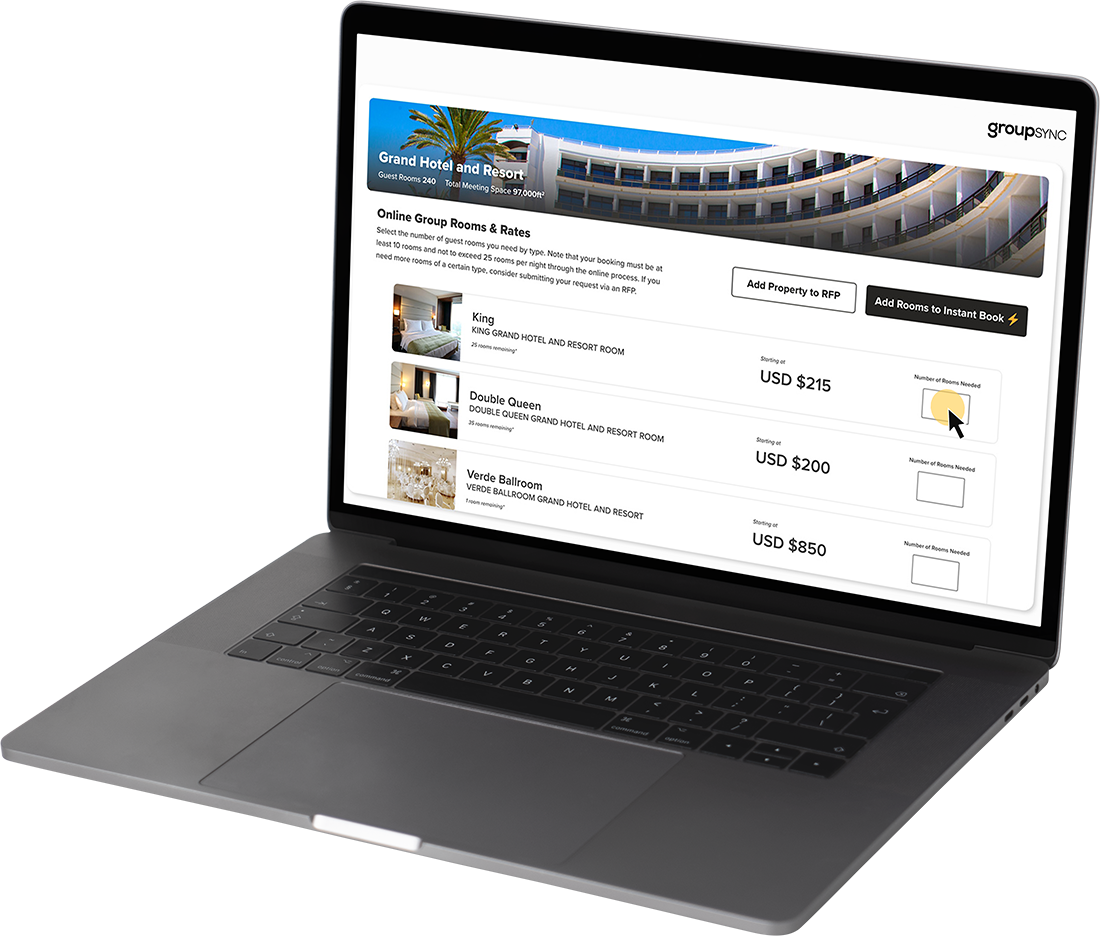7 Ways to
Unlock Easier
Event Planning
Chapters
Whether you’re juggling angsty stakeholders or dozens of vendors in various stages of the planning process – planning large events or booking group travel can feel like a non-stop relay race of questions and answers.
We know that creating amazing experiences starts with exceptional communication but that can be challenging when you’re swamped with details and inundated with questions.

- What restaurant options are onsite or within walking distance?
- Will the conference room have A/V available?
- Can we set up our snack and meal time differently for each day?
How do you create amazing event experiences without running yourself ragged answering all those questions or handling miscommunication?
We’ve got some ways to help you plan and execute your event planning with less frustration for both you and your stakeholders.
7 Ways to
Unlock Easier Event Planning
How does this make event planning easier? We’re sharing actionable tips – not gimmicks, or gadgets. They’re logical applications and rooted in the science of human nature (biology and psychology) so they’re incredibly effective at smoothing the path for better experiences and fewer problems when planning your event.

As humans, we’re naturally risk averse creatures. Instinctively, we want to be safe and look for smooth, predictable outcomes. Any sign of trouble alerts our subconscious spidey senses and puts us on edge. Pretty hard to enjoy ourselves at a work conference or industry event when we’re on high alert – looking for things that might go off the rails! So, how can we take this understanding of human nature and create a smoother planning experience for successful events?
Let’s take a look at these 7 ways to create smoother experiences for both you and your stakeholders.


01 Lower Perceived Risk
As the planner in charge of sourcing venues and coordinating vendors to plan a flawless event, your job is to imagine all the scenarios of how things can go sideways. Heck, you’ve probably experienced every weird and wacky thing that can go wrong with an event! With your resourcefulness, you mitigate risks and know how to handle unexpected scenarios.
Your stakeholders or attendees, on the other hand – most likely don’t have the benefit of your experience or your direct line of communication with the event facilities team, caterers, hotel team, transportation vendors, et cetera.
They’re out there, hoping for the best, trusting that you’re going to handle every last detail but when the unknown is looming, trust can often be overrun by worry and doubt.
So how do we help them overcome the fear of being disappointed or disappointing others? Manage and lower their perceived risk.
How do you lower the perception of risk?
Clear communication and expectations, as we’ll share more about in this guide, are excellent ways to help reduce anxiety about outcomes.
Sharing details about hotel venues, facilities, vendors, and logistics at each step of the process can help your stakeholders or attendees know what to expect so they’ll imagine themselves comfortable in the conference space, happy with their hotel rooms, or enjoying their meal at the on-property restaurant. Guessing equals stressing, so share early and share often to boost confidence that you’ve got everything handled (pssst – this can also result in fewer questions or back and forth exchanges).


02 Humanize and Personalize
We know you’re charged with creating phenomenal experiences at the big conference or special event. But what about during the planning process? Can the process of working with you be a phenomenal experience for stakeholders too? We love processes and systems that create repeatable successes, but it’s easy to swing too far the other way and leave stakeholders feeling like they’re talking to a robot.
Helping people feel valued and “human” goes a long way to making a memorable experience (ahem, read “repeat customers”!).
How do we help our stakeholders feel human?
- Get personal: Use their names to create interpersonal connections.
- Be curious: Take a few extra moments to ask questions about them and about their event.
- Listen: Be empathetic to their concerns and fears.
- Share your personality: Use video messages to give insights, keep stakeholders updated, and let your personality and “human-ness” connect with theirs.
Simply pausing to bring a warm, human element that meets stakeholders with enthusiasm can help build trust and ensure their experience is memorable and delightful before the event even begins.


03-visual-elements
As we already mentioned, video messages or video updates help humanize the stakeholder’s experience because it’s the next best thing to talking to them in person. Back to that “being human” business, we process visuals faster than words, so a picture really is worth 1000 words! Photos of hotel rooms, outdoor spaces, amenities, or video tours of properties help alleviate the fear of the unknown and help your stakeholders feel more comfortable and confident in what’s to come because once they see the venue, rooms, or amenities, they begin imagining themselves at the event.
Adding visual elements helps your stakeholder or attendees get excited and imagine themselves there, at the event, and anticipating its success!

04 Set Expectations and Next Steps
Just because you know what comes next, doesn’t mean that your stakeholders will, or that they’ll remember what you’ve shared with them.
Next steps often get lost when we’re focused on other details or juggling dozens of emails, timelines, spreadsheets, documents…you get it. You live it, right?!
Here are a few simple strategies to incorporate in your communications process that can help cut down delays on approvals, selections, or milestones:
- Include action items needed in subject lines. This defines the focus of your message before they even open the email, and when left in their inbox, this specific subject line gently nudges them to take action.
- Recap every conversation with a clear delineation of who does what and by when. So many details can “fall out” of our short-term memory even ten minutes after a meeting if we don’t document them. When you have a call to discuss options or make decisions, you should immediately capture the who, what, and by when details so that everyone walks away with clear assignments that can prevent costly time delays and more of the dreaded question and answer email volleys.
- Set calendar meetings with clear meeting titles and agendas in the invitation. Your time is precious and when you meet with decision makers, it can feel like herding cats when everyone has ideas and opinions. You’re probably a pro at handling that by now, but a “next level” move here is to get super clear about what the meeting participants can expect. A pro level agenda can be included in the meeting invite to clearly spell out the purpose of the meeting, intention of outcomes to be decided, specific time for discussion, and who needs to contribute, prepare, et cetera.
Setting expectations early and often doesn’t just help keep your event on track and cut down on wait time or miscommunication, it also helps boost those feelings of trust and confidence as your stakeholders know they won’t be surprised by what’s to come!

05 Repeat, Reiterate, and Reinforce
Just like setting expectations early and often, repeating, reiterating, and reinforcing key information helps boost confidence and trust. These 3 R’s are taking a tip from teaching and training. We don’t remember things often after hearing or seeing them just once. Important deadlines, decisions, or stipulations can be easily overlooked if mentioned only once, say 4 months ago, or buried on page 7 of an RFP or contract.
For example, against Kate’s advice, her stakeholder decided against an afternoon snack selection during the days of the conference so they can use the budget for an open bar in the evening (whoa, empty bellies up to the bar – that can be a recipe for disaster).
Kate reiterated their decision and her suggestion to include afternoon snacks in emails and in the contract and even left a note about how much the afternoon snack would be to add on so her stakeholder could change their mind.
Later, when the stakeholder heard rumblings about no snacks, they were able to quickly recall that Kate had advised them to have those on hand and asked her to have them ready for the remaining days of the conference, warding off “hangry” complaints and creating happier attendees.
Repetition, reiteration, and reinforcement isn’t only to prevent blowback when a client doesn’t follow your advice. Repeating great ideas, what’s next, and exciting moments to come lead to smoother communication and expectations, meaning happier stakeholders and attendees and a happier, less stressed YOU.

06 Clear Communication
You might think all of these tools are part of being a top notch communicator – and, you’re right! However, there is a big part of communication that depends on your audience’s ability to receive your message. Here’s some of that psychology we promised.
Our ability to read or digest messages has a lot to do with our current state of cognitive overload. Our cognitive load is our short term working memory and the amount of stimuli, distractions, tasks, and “noise” we’re experiencing at any given time.
With the barrage of media and incoming stimuli we experience daily, it’s easy to become overwhelmed or “cognitively overloaded” earlier and earlier each day. This includes work related things such as emails, text messages, notifications, interruptions – not to mention things like traffic jams, sick children, home repairs, aging parents, et cetera.
How do we help our audience or clients receive messages to be better communicators? Take into consideration cognitive load and make your messages easier:
- Leverage visual writing to make your messages scannable.
- Use bullet points, bold texts on questions and next steps.
- Use the “subject line” next steps to make the point of the message incredibly clear and simple to take action on.
- Keep it short and sweet. If your message requires exposition, explanation, or more than two paragraphs, either schedule a call or use a video explainer message to humanize and personalize your communication.
Developing your clear and concise communication tools helps prevent misunderstandings and missed opportunities to WOW both your stakeholders and attendees, giving everyone a better experience all around.


07 Ask Questions
- Ask questions to clarify what they do or don’t understand. Where are common areas that cause confusion?
- Ask questions about their expectations in areas it might be murky or where they’re working with a vendor outside your scope.
- Listen and ask questions to clarify when your stakeholder could be mixing up their terminology.
Pausing to ask questions helps you get and stay aligned with your stakeholder to keep misunderstandings to a minimum. Getting and staying on the same page calls back to the opportunity to help them know what to expect and anticipate success all along their journey in event planning or the group booking process with you.

At Groups360, we get it.
You want a smooth and easy process for booking hotels for groups and events.
We know firsthand how time consuming it is to coordinate the needs of your event, find and source hotels, check inventory, and wait for sales teams to get back to you.
That’s why we built GroupSync – the simpler way to search, source, and book hotels for your group or event needs.
Don’t just take our word for it – check it out for free:
- Click over to GroupSync.com.
- Sign Up for your free account.
- Take a look around at the thousands of properties and hotel venues ready with up-to-date availability and pricing, right at your fingertips.
Find out how easy booking hotels for groups can be.



